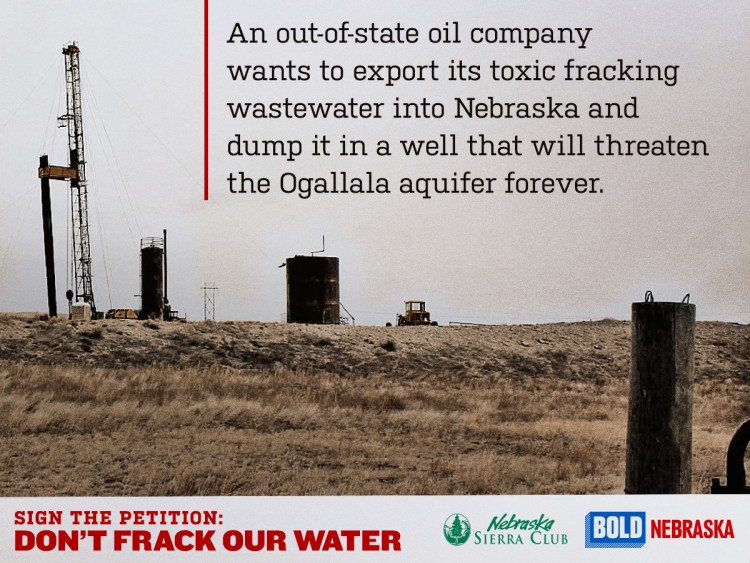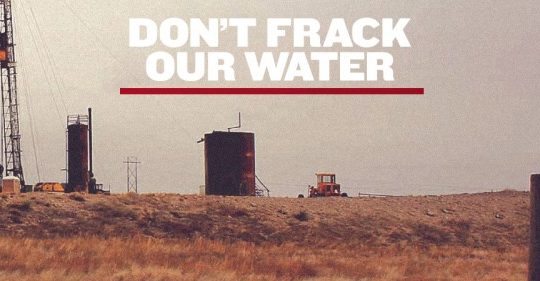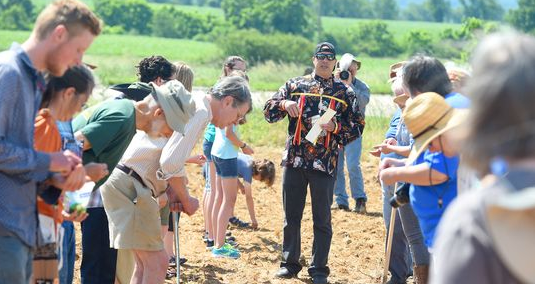

SIGN THE PETITION: DON’T FRACK OUR WATER
- PUBLIC HEARING: March 24, 10:00 a.m. MT (*11:00 a.m. CT*)
- Nebraska Oil & Gas Conservation Commission
922 Illinois Street
Sidney, Nebraska 69162 - If you can’t attend the hearing, send a written letter with your comment to the address above or via email: NOGCC@nogcc.ne.gov
LISTEN: Nebraska public radio (NET Nebraska) reports on the proposed fracking well, including the shady business dealings of Terex, the Colorado-based company applying for the permit to create the well, and the shocking lack of regulation of wastewater injection wells in Nebraska.
LISTEN: Public radio service InsideEnergy.org reports on the phenomenon of fracking wastewater injection wells increasingly polluting the landscape amid the U.S. oil boom, and speaks with the CEO of Terex about the proposed well in Sioux County.
WATCH: Local landowners in Sioux County, Nebraska voice their concerns about the proposed fracking wastewater well before the County Board.
An out-of-state oil company with a questionable track record wants to export its toxic fracking wastewater into Nebraska, moving 80 truckloads carrying 10,000 barrels per day of pollution destinted to be dumped into a disposal well in Sioux County.
The Colorado-based company wants to transfer the risks of its toxic pollution onto Nebraska farmers and ranchers and our land and precious water resources.
Sign the petition: Don’t frack our water.
Threatens the Ogallala Aquifer
The well would be by far the largest of its kind in Nebraska — dwarfing any of the other 115 existing injection wells in the state. Wastewater from the fracking process would be pumped down directly through the Ogallala aquifer, posing a perilous danger to the precious underground water source that provides drinking water for millions of people and 30% of irrigation for our agricultural economy.
Not only does the process of “fracking” for oil and gas consume huge volumes of water — as many as 10 gallons of wastewater created to drill out every gallon of oil — but after it’s used in the drilling process, the water is then contaminated and must be disposed of with similar precaution as radioactive waste. In fact, fracking wastewater is often radioactive itself, due to solids it picks up underground during the drilling process.
What’s worse, when it spills, wastewater is particularly damaging to agricultural land, where the effects can last decades or even generations, according to North Dakota State University soil scientist Larry Cihacek. [1]
In Nebraska, if the well casing were to fail on Terex’s proposed injection well, it would be impossible to clean up a toxic wastewater spill inside the Ogallala aquifer.
Nebraskans depend on clean water from the Ogallala aquifer for life and for our livelihoods. We can’t afford to risk our grandchildren’s future by allowing the injection of exported pollution into our soil and through our aquifer.
Protect the Ogallala aquifer: Don’t frack our water.
Click here to add your name to the petition.
Nebraska has almost no standards to regulate disposal of fracking waste, which is the reason out of state corporations want to dump their wastewater in our state.
In fact, the head of the Nebraska Oil and Gas Commission even recently acknowledged in an interview that Nebraska “has a less demanding regulatory structure for disposal wells compared to neighboring states which can make the approval process faster.” [2]
The Nebraska Oil and Gas Conservation Commission’s mission is to promote development and production of oil and gas in our state, not to regulate it.
Further, the Nebraska Legislature should halt the dumping of fracking wastewater in our state until we have adequate standards to protect our land and water — Nebraska’s lifeblood, and key to our productive future.
Earthquakes in Nebraska?
The drilling of wastewater injection wells has also been tied to an alarming rise in the frequency and strength of earthquakes in frack-friendly states like Oklahoma, which had 574 earthquakes with a magnitude of 3.0 or greater in 2014 — more earthquakes than the state of California had last year. [3]
A new study from the U.S. Geological Survey found that these smaller earthquakes could also be putting fracking zones at risk for major ones. [4]
Local concerns
In addition to the dangers outlined above, local landowners also have expressed serious concerns about the volume of toxic wastewater that will be exported into Nebraska, with 80 tanker truckloads per day that will be passing schools and putting enormous burden on rural county roads they depend on for their livelihoods, to get their produce and livestock to market.
The County Boards of both Scottsbluff County and Sioux County, Nebraska have sent letters voicing their opposition to the proposed fracking well to the Oil & Gas Commission. [5]
A public hearing on the well is scheduled for March 24, and citizens’ comments are being accepted now.
Add your name: Tell the Commission to REJECT the fracking wastewater well permit.
Optional for Nebraska residents: Leave a comment under your signature, to be delivered as public comment to the Nebraska Oil & Gas Conservation Commission.
REFERENCES
1. “State Officials Misrepresent North Dakota’s Spill Problem,” InsideEnergy.org, 2/16/15
2. “Oil Field Brine Disposal Pits Colorado Business Against Nebraska Landowners,” NET Nebraska, 2/4/15
3. “Oklahoma Temblors Outpace California as Fracking Booms,” Bloomberg, 8/7/14
4. “Small Earthquakes Linked To Fracking Could Lead To Major Ones,” ThinkProgress.org, 2/16/15
5. “Sioux County Board Approves Letter Opposing Wastewater Well,” KNEB.com, 2/18/15



